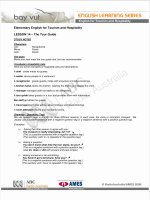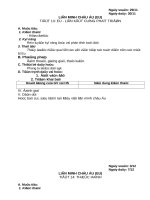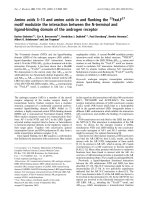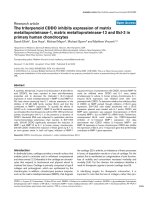Class 13 and class 14
Bạn đang xem bản rút gọn của tài liệu. Xem và tải ngay bản đầy đủ của tài liệu tại đây (156.16 KB, 10 trang )
Development Finance, MPP, VJU
Prof. Koji Fujimoto
Class 13 and Class 14 Three Analytical Themes on Development Finance
Financing development can be partly understood by analyzing particular themes to
which development practitioners might have been seeking answers. In our present
lecture, three such themes are briefly analyzed below.
The themes are:
> Measuring Investment Needs for the Economic Growth of the Developing Country,
> Relationship between the Development Budget and the Balance of Payments for
Foreign Debt Management, and
> International Capital Needs/Availability for Economic Development of the Third
World.
The following analyses simply ‘scratch’ the surface. On the other hand, such analyses
suggest that they would become excellent research themes for future theses and
dissertations, once analytical methods are further elaborated and empirical analyses are
carried out after collecting statistical data.
1. Measuring Investment Needs for Economic Growth of the Developing Country
(1) Economic Growth and ICOR
The relationship between economic growth and ICOR is, in its simplest form,
expressed in the equation as follows,
∆Y/Y = I/Y ÷ I/∆Y (or ∆K/∆Y) ---------------------------------------------- (1)
where ∆Y/Y is Economic Growth Rate, I/Y is Investment Ratio and I/∆Y
(or ∆K/∆Y) is ICOR.
This equation implies that ICOR as well as the investment ratio play an important
role in promoting economic growth. The higher the ICOR becomes (other things
being equal), the lower the economic growth rate becomes. And, the higher the
investment ratio becomes, the higher the economic growth rate becomes (other
things being equal).
In developing countries, considerable attention and importance is given to ICOR
when analyzing economic growth. There are at least two major reasons. One is
that scarce capital is often the determinant of economic growth while labor tends
to be supplied in excess (on the contrary, in developed countries labor sometimes
1
Development Finance, MPP, VJU
Prof. Koji Fujimoto
becomes the restrictive factor in determining economic growth because of
population decrease). The second reason is that it is often quite difficult to analyze
the production function where three factors of production (capital, labor and TFP)
are involved, as reliable data are not available.
The view above suggests how important it is to investigate investment in analyzing
economic development in developing countries. Let us, then, analyze a specific
investment need to attain a certain level of economic growth by a simple case
study by manipulating the equation (1).
The equation (1) is re-written by introducing a time-lag factor as follows.
(Yt – Yt-1)/(Yt-1) = (It)/(Yt-1) ÷ (It)/(Yt – Yt-1) ------------------------ (2)
Let us further assume that GDP in the year of t-1 is US$120 billion. In order to
attain an economic growth rate of 6% {G t = (Yt – Yt-1)/Yt-1}, namely to attain
$127.2 billion, on condition that ICOR does not change from the previous year at
4.5, investment has to reach $32.4 billion (therefore, the investment ratio in the
year of t is 27%) in the year t.
Similarly, if an economic growth of 6.5% in the year of t+1 with ICOR of 4.5 is
desired, investment in the year of t+1 has to reach US$37.21 billion (the
investment ratio is 29.3%). The fact that ICOR stays constant at 4.5 and the
economic growth rate increases from 6% to 6.5% implies that a considerable
increase in investment is needed. Further, if we want to achieve an economic
growth rate of 6.5%, in the year of t+2 with ICOR {I t+2/(Yt+2 – Yt+1)} of 4.2
(improved from previous 4.5 to 4.2), investment in the year of t+2 has to reach
US$36.98 billion (a decrease of US$0.2 billion, and the investment ratio 27.30%).
The fact that ICOR is improved from 4.5 to 4.2, while the aimed economic growth
rate remains constant at 6.5%, suggests that investment does not always need to be
increased. As a matter of fact, the amount of investment in year t+2 decreased
slightly from that of year t+1 owing to the improvement of ICOR.
The above equation (2) enables us to project economic growth rates and trends
based on past economic performances. In other words, once the GDP, investment
and ICOR are obtained on the basis of past economic performances, we can
project future economic growth for economic development planning. Table 1
below shows what is discussed above more comprehensively over 4 years.
(Read Reference 1 Singer, H.W. “Is Development Economics Still Relevant ?”, and
comment on its contents.)
2
Development Finance, MPP, VJU
Prof. Koji Fujimoto
Table 1 Economic Growth and Investment
G (%)
Year t–1
Y
Unit: billion
∆Y
I
I/Y (%)
120.00
ICOR
4.5
Year t
6.0
127.20
7.20
32.40
27.3
4.5
Year t+1
6.5
135.47
8.27
37.21
29.3
4.5
Year t+2
6.5
144.27
8.81
36.98
27.3
4.2
(2) Public Sector Investment and Funding
Investment is broadly divided into two kinds; public investment and private
investment. The equations above include both public investment and private
investment. In other words, “I” denotes the total investment of both public and
private. As far as public investment is concerned, the government determines its
level when the budget is prepared on the basis of the economic growth target and
the assumed division of labor in investment. The simplest way of setting a level of
public investment is to divide the country’s required annual investment on a pro
rata and historical trend basis.
Once a level of public investment is determined, the government needs to secure its
sources. The government generally finances its investment expenditure
domestically through tax revenues and domestic government borrowing. If these
two measures suffice the investment expenditure requirement, the need to procure
funds from abroad both or either in the form of loan and/or grants does not exist.
Generally speaking, however, developing countries plan ambitiously to attain a
high economic growth in spite of budgetary constraints. They then turn around to
request industrialized countries and multilateral aid organizations to supplement
their financial shortages through ODA, OOF and PF. The developing countries, as
a matter of course, prefer and seek softer conditioned funds from abroad such as
ODA.
In addition, it should be noted that a large number of developing countries have
long made it a rule to integrate foreign financial assistance into annual budgetary
procedures.
(3) The Case of REPELITA VI and Its Economic Growth Targets (Economic Growth
Rate, ICOR and Investment Ratio)
3
Development Finance, MPP, VJU
Prof. Koji Fujimoto
The Government of Indonesia set forth economic growth targets in the REPELITA VI
(1994~1998) plan as shown in table 2. Those targets suggest that the Indonesian
Government, in an attempt to attain the economic growth rate of 6.2%, put special
emphasis on maintaining its investment ratio at a 27% or 28% level and to
improve investment efficiency by reducing ICOR from 4.5 (1994) to 4.3 (1998).
High economic growth and the stabilization of the external balance of payments are
twin macroeconomic objectives. However, if the economic structure remains
unchanged, these objectives are antinomic to each other. High economic growth
requires high investment and high investment results in considerable foreign
borrowing, which in turn deteriorates the external balance of payments. It is
evident that REPELITA VI tried to avoid this antinomy by improving investment
efficiency through a more efficient economic structural change.
It is, however, generally evidenced that ICOR deteriorates (increases) temporality at
the stage of “the pre-conditions for take-off into self-sustaining growth” as public
investment in new and renewal economic infrastructure considerably increases. In
order to decrease ICOR, the government has to continue its policy reform efforts
to create a more efficient economic structure through deregulation, market
liberalization and so on.
Table 2 REPELITA VI and Macroeconomic Targets
ICOR
Investment Ratio
(%)
Economic Growth
Rate (%)
1994
4.5
27.0
6.0
1995
4.5
27.0
6.0
1996
4.4
27.3
6.2
1997
4.4
28.2
6.4
1998
4.3
28.4
6.6
2. Relationship between the Development Budget and the Balance of Payments for
Foreign Debt Management
(1) Foreign Borrowing in the National Budget and Debt Repayment (Debt Service)
(i) State Budget System of the Developing Countries
The budget system in developing countries often consists of the “Development
Budget” and the “Routine (or Recurrent) Budget.” Needless to say, the budget
system has two sides for each budget, revenue and expenditure. There are, of
4
Development Finance, MPP, VJU
Prof. Koji Fujimoto
course, many developing countries whose budget system is characterized as one
united budget, not two types of budgets. This is increasingly true recently as the
mid-term expenditure review methodology has been widely introduced in
developing countries. Indonesia, too, abandoned the traditional two-budget-system
several years ago. Even for the budget system which is not divided into two, we
can conceptually sort out the above discussion as shown in figure 1 below.
The domestic routine expenditure is intended to be used for the fixed annual
expenses and, therefore, it has to be spent every year, while the development
expenditure (domestic development expenditure and project aid expenditure) is
intended to be used for investment on the part of the government (public
investment) to achieve, say, 6% of country’s economic growth. As figure 1 below
indicates, the project aid expenditure, which is equal to the project aid revenue, is
foreign capital inflow (loans and grants) that is to supplement the domestic
development expenditure which aims to attain, for example, an economic growth
of 6%. (Refer to the Two Gap Model)
Figure 1 Structure of Budget System of Developing Country
(ii) State Revenue and Development Revenue ~ with an Interest in Indonesia~
The breakdown of state revenues of Indonesia in 1997/98 is shown below.
Revenues (in billion rupiah)
a. Domestic Revenues
Rp. 88,069.7
① Oil and gas revenues
Rp. 14,871.1
② Non-oil and gas revenues
Rp. 73,198.6
Income tax
Rp. 29,117.1
5
Development Finance, MPP, VJU
Prof. Koji Fujimoto
Value added tax
Rp. 24,601.4
Import duties
Rp. 3,321.7
Excise
Rp. 4,436.3
Export tax
Rp. 100.0
Land and building tax
Rp. 2,505.0
Other taxes
Rp. 632.0
Non-tax revenue
Rp. 8,225.8
Net oil profit
Rp. 249.2
b. Development Revenue
Rp. 13,026.0
Project Aid (Loans and Grants)
Rp. 13,026.0
Generally speaking, in developing countries the government revenue tends to fall
short of the required routine and development expenditure. In order to supplement
the shortage, governments can issue government bonds (denominated in domestic
currency) and sovereign bonds (denominated in foreign currencies), or borrow
from foreign governments and MDBs in the form of ODA and /or OOF. In the
case of Indonesia, the government maintains a balanced budget meaning that
expenditures equal to revenues (including foreign, but not domestic borrowing).
“Project Aid” means, therefore, foreign borrowing. No domestic borrowing is
assumed.
(iii) State Expenditure and Foreign Debt Service
Expenditures (in billion rupiah)
a. Routine Expenditures
Rp. 62,167.8
① Personnel Expenditures
Salary and pension
Rp. 17,084.4
Rice allowance
Rp. 1,309.5
Food allowance
Rp. 1,233.7
Other domestic staff
expenditure
Rp. 1,009.9
Other overseas staff
expenditure
Rp. 590.5
② Expenditure on Goods
Domestic purchases
Rp. 8,478.0
Overseas purchases
Rp. 417.2
③ Subsidies to Provincial and Local Government
Personnel expenditure
Rp. 10,967.8
6
Development Finance, MPP, VJU
Prof. Koji Fujimoto
Non-personnel expenditure
Rp. 568.0
④ Interest and Debt Repayment
Domestic debt
Rp. 334.2
Overseas debt
Rp. 19,236.7
⑤ Other Routine Expenditures
Rp. 964.9
b. Development Expenditures
Rp. 38,927.9
① Rupiah Expenditures
Rp. 25,901.9
② Project Aid
Rp. 13,026.0
Over the two oil crises of 1973 and 1978/79, many non-oil producing developing
countries accumulated foreign debt. The serious foreign debt problem of the
Third World prevailed during the ‘80s, which threatened to collapse the
international financial system. Fortunately, owing to enormous efforts by the
lenders of developed countries and borrowers of developing countries, the
international financial system survived. This experience demonstrated to us that
foreign debt management is one of the most important macroeconomic policies.
In other words, the government of developing country must grasp the real time
state of affairs on debt service obligation vis-à-vis their state budget. By doing
so, the government of any developing country can pursue a prudent debt
management policy.
The case of Indonesia above shows us that the foreign debt service shares
21%~22% against domestic revenues (total state revenue). This ratio is quite
high, but is presumably within the sustainable level.
On the other hand, the government needs to secure the development revenues for
development expenditures to attain their economic growth target, regardless of
the foreign debt services.
Another issue to which we have to pay attention to is that the figures of
“Development Expenditures” are shown in gross disbursement terms. Net
disbursement figures (“Project Aid Expenditures” minus “Overseas debt”) are
regularly used in DAC statistics. However, in our present analysis, net figures
proved to be not very useful.
(2) Relationship between Domestic Budget and Balance of Payments
In case that the government of a developing country secures revenues for development
expenditures in the form of project loan aid, figures which appear in the Capital
7
Development Finance, MPP, VJU
Prof. Koji Fujimoto
and Financial Account for the Balance of Payments are in conformity with
figures that appear in the Development Expenditures of the State Budget. To be
more specific, it should be elaborated as follows.
Gross disbursement figures that appear in the “Other Investment (Loan)”
of the “Capital and Financial Account” are equal to the gross disbursement
figures that appear in the “Development Project Aid (Loan)” of the
“Development Expenditures.”
Gross disbursement figures that appear in the “Capital Account (Grant)” of
the “Capital and Financial Account” are equal to the gross disbursement
figures that appear in “Development Project Aid (Grant)” of the
“Development Expenditures.” As this case deals with grant project aid,
gross disbursement is equal to net disbursement.
From a viewpoint of debt servicing, the following two relationships need to be
pointed out.
Gross figures of interest payments that appear as “Income” (of “Current
Account”) under the Balance of Payments are equal to figures of interest
payments that appear in the “Overseas debt” (of “Interest and Debt
Payment”) of the “Routine Expenditures.”
Gross figures of principal repayment that appear as “Other Investment” (of
“Capital and Financial Account”) under the Balance of Payments are equal
to figures of principal repayment that appear as “Overseas debt” (of
“Interest and Debt Repayment”) of the “Routine Expenditures.”
It is difficult to evaluate the relationship between the development budget and the
balance of payments on an ex post basis. However, the kind of analysis shown
above helps to understand the relationship between the budget and the balance of
payments in terms of effective and efficient foreign debt management.
3. International Capital Needs/Availability for Economic Development of the Third
World
There are at least the following five types of capital fund flows into the Third World,
which are deemed to contribute to its economic development. The industrialized
countries should be bound to secure the maximum financial resources on those fronts.
(Read Reference 2 Rt. Hon Simon Upton, “What Should World Leaders Focus on at
the Johannesburg Summit?” 2002, and summarize and comment on its discussion
concisely.)
(1) Official Development Assistance
8
Development Finance, MPP, VJU
Prof. Koji Fujimoto
Since the Pearson Report of ’69, the targeted ODA of 0.7% of GDP of the donor
countries has not been attained. How can we possibly implement this promise and
when we meet this target, how much is available for the Third World?
(2) Philanthropy
As a source of development assistance, philanthropy should be encouraged by the
international public or the civil society. How much, then, is available for the Third
World?
(3) Foreign Direct Investment (FDI)
FDI could be a driving force of economic development for developing countries. It is
expected that globalization helps to increase FDI in a more equitable manner. How
can we help promote FDI? How much FDI capital flow would be available for the
Third World?
(4) Trade Liberalization
A variety of trade barriers imposed by developed countries should be lifted. Trade
liberalization on the part of the developed world must give tremendous economic
benefits to the Third World. What would the value of trade liberalization be worth
to developing countries?
(5) Freer Movement of People including Migration
It is well known that expatriate remittances are one of the major foreign exchange
earnings for many developing countries. There are pros and cons on free
movement of people. However, these remittances contribute to economic
development considerably. How much more could developing countries benefit if
the restriction of freer movement of people in developed countries be allowed?
✍
9
Development Finance, MPP, VJU
Prof. Koji Fujimoto
(For reference) Balance of Payments Headings
Current Account
Goods and Services
Trade Balance
Exports
Imports
Services
Income ・・・・・・・・・・・・・・・・・・・・・・・(Interest Payment, Remittance by
migrant workers, etc.)
Current Transfers ・・・・・・・・・・・ (Grants for consumer goods,
Contributions to international
organizations, etc.)
Capital and Financial Account
Financial Account
Direct Investment
Portfolio Investment
Other Investment ・・・・・・・・・・ (Loans, Trade Credits, etc.)
Capital Account ・・・・・・・・・・・・・・・・ (Grants for capital projects, etc.)
Changes in Reserve Assets
Errors and Omission
10









